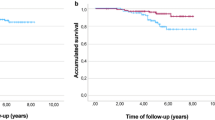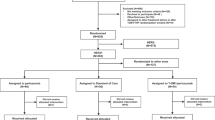Abstract
Background
Pertuzumab became a standard part of neoadjuvant therapy for human epidermal growth factor receptor 2-positive (HER2+) breast cancers approximately halfway through Neoadjuvant Breast Registry Symphony Trial (NBRST) enrollment, providing a unique opportunity to determine biologically which clinical HER2+ patients benefit most from dual targeting. As a neoadjuvant phase 4 study, NBRST classifies patients by both conventional and molecular subtyping.
Methods
Of 308 clinical HER2+ patients enrolled in NBRST between 2011 and 2014 from 62 U.S. institutions, 297 received neoadjuvant chemotherapy (NCT) with HER2-targeted therapy and underwent surgery. This study compared the pathologic complete response (pCR) rate of BluePrint versus clinical subtypes with treatment, specifically differences between trastuzumab (T) treatment and trastuzumab and pertuzumab (T/P) treatment.
Results
In this study, 60% of the patients received NCT-T, and 40% received NCT-T/P. The overall pCR rate (ypT0/isN0) was 47%. BluePrint classified 161 tumors (54%) as HER2 type, with a pCR rate of 65%. This was significantly higher than the pCR rate for the 91 HER2+ tumors (31%) classified as luminal (18%) (p = 0.00001) and the 45 tumors (15%) classified as basal (44%) (p = 0.0166). The patients treated with T/P had higher pCR rates than those treated with trastuzumab alone. The difference was most pronounced in the BluePrint luminal patients (8 vs. 31%). The highest pCR was reached by the BluePrint HER2-type patients treated with T/P (76%).
Conclusions
The addition of pertuzumab leads to increased pCR rates for all HER2+ patient groups except for the BluePrint basal-type patients. This better response was most pronounced for the BluePrint luminal-type patients.




Similar content being viewed by others
References
Swain SM, Baselga J, Kim SB, et al. Pertuzumab, trastuzumab, and docetaxel in HER2-positive metastatic breast cancer. CLEOPATRA Study Group. N Engl J Med. 2015;372:724–34.
Schneeweiss A, Chia S, Hickish T, et al. Pertuzumab plus trastuzumab in combination with standard neoadjuvant anthracycline-containing and anthracycline-free chemotherapy regimens in patients with HER2-positive early breast cancer: a randomized phase II cardiac safety study (TRYPHAENA). Ann Oncol. 2013;24:2278–84.
Gianni L, Pienkowski T, Im YH, et al. Efficacy and safety of neoadjuvant pertuzumab and trastuzumab in women with locally advanced, inflammatory, or early HER2-positive breast cancer (NeoSphere): a randomised multicentre, open-label, phase 2 trial. Lancet Oncol. 2012;13:25–32
Retrieved 27 June 2016 at http://www.fda.gov/drugs/informationondrugs/approveddrugs/ucm370449.htm.
Gradishar WJ, Anderson BO, Balassanian R, et al. Invasive Breast Cancer Version 1.2016, NCCN Clinical Practice Guidelines in Oncology. J Natl Compr Cancer Network. 2016 Mar;14(3):324–54.
Perou CM, Sørlie T, Eisen MB, et al. Molecular portraits of human breast tumours. Nature. 2000;406:747–52
Krijgsman O, Roepman P, Zwart W, et al. A diagnostic gene profile for molecular subtyping of breast cancer associated with treatment response. Breast Cancer Res Treat. 2012;133:37–47.
Cardoso F, van’t Veer LJ, Bogaerts J, et al. Prospective validation of the 70-gene signature in early breast cancer. N Engl J Med. 2016;375:717–29.
Glück S, de Snoo F, Peeters J, Stork-Sloots L, Somlo G. Molecular subtyping of early-stage breast cancer identifies a group of patients who do not benefit from neoadjuvant chemotherapy. Breast Cancer Res Treat. 2013;139:759–67.
Prat A, Bianchini G, Thomas M, et al. Research-based PAM50 subtype predictor identifies higher responses and improved survival outcomes in HER2-positive breast cancer in the NOAH study. Clin Cancer Res. 2014;20:511–21.
Perez EA, Ballman KV, Mashadi-Hossein A, Intrinsic subtype and therapeutic response among HER2-positive breast tumors from the NCCTG (Alliance) N9831 Trial. J Natl Cancer Inst. 2016; 109:djw207
Whitworth P, Stork-Sloots L, de Snoo FA, et al. Chemosensitivity predicted by BluePrint 80-gene functional subtype and MammaPrint in the Prospective Neoadjuvant Breast Registry Symphony Trial (NBRST). Ann Surg Oncol. 2014;21:3261–7.
Viale G, Slaets L, de Snoo FA, et al. Pathological assessment of discordant cases for molecular (BluePrint and MammaPrint) vs clinical subtypes for breast cancer among 6694 patients from the EORTC 10041/BIG 3-04 (MINDACT) trial (abstract). In: Proceedings of the Thirty-Seventh Annual CTRC-AACR San Antonio Breast Cancer Symposium, 9–13 December 2014, San Antonio, TX. AACR, Philadelphia, PA. Cancer Res. 2015;75(9 Suppl). Abstract nr P4-11-08.
Acknowledgement
We are grateful to all the women who participated in this study and all the investigators, surgeons, pathologists, and research nurses. The study was sponsored by Agendia. The authors also thank Erin Yoder (Agendia Inc.) for data management support.
Disclosure
Femke de Snoo and Lisette Stork-Sloots were employees of Agendia at the time of the analysis and are consultants to Agendia for this work. Pat Whitworth and Peter Beitsch received honoraria from Agendia.
Author information
Authors and Affiliations
Corresponding author
Rights and permissions
About this article
Cite this article
Beitsch, P., Whitworth, P., Baron, P. et al. Pertuzumab/Trastuzumab/CT Versus Trastuzumab/CT Therapy for HER2+ Breast Cancer: Results from the Prospective Neoadjuvant Breast Registry Symphony Trial (NBRST). Ann Surg Oncol 24, 2539–2546 (2017). https://doi.org/10.1245/s10434-017-5863-x
Received:
Published:
Issue Date:
DOI: https://doi.org/10.1245/s10434-017-5863-x




